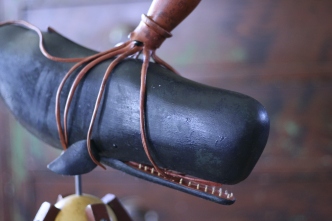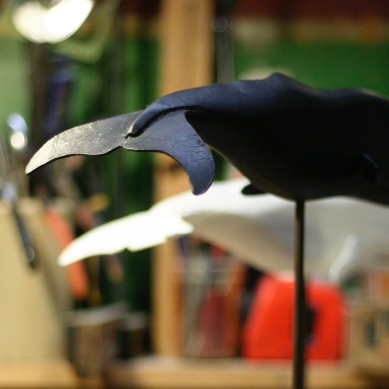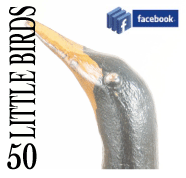There have been some big changes in the way that I think about my work. My birds and whales and my put-toys are gaining notice in new and exciting markets. In response to all of this new attention I’m thinking and writing about my work. In doing this I stumbled across this piece that I wrote in the summer of 2015. I had been back from my life-changing canoe trip for about a year and was beginning to see what it meant for my work. This piece holds true today. This is what I do — and with little change — the way that I think about what I do. I encourage your comments and thoughts.
The only change that I have made is to update photographs with new work.
Many more big changes to come.
 I carved very little over the last year. The year was spent preparing for a six week solo canoe expedition on the Northern Forest Canoe Trail. A year ago I was on the trail — somewhere in Northern Vermont. The purpose of the trip was to inform and inspire many of the carvings that I’m working on now.
I carved very little over the last year. The year was spent preparing for a six week solo canoe expedition on the Northern Forest Canoe Trail. A year ago I was on the trail — somewhere in Northern Vermont. The purpose of the trip was to inform and inspire many of the carvings that I’m working on now.
It’s great to be carving again. My canoe trip has inspired a series of fifty birds. I’ve completed the first dozen. It is my best work. I’ve returned to the work with a fresh approach and a new eye.
I’ve written about how I carve birds many times. Since I’ve returned from my canoe trip and have begun to carve the birds of the Northern Forest my work has gained new interest. It’s time to revisit this again.
1) My Carvings Tell a Story
My carvings — with a very few exceptions — represent a personal experience with the subject. Until I have my own story a bird is off limits. It is not unusual for me to seek new birds so that I my carve them and share the stories.
2) There are Exceptions – But They Still Have a Story
I carve things other than birds — whales, polar bears, boats — that stir me. There is still a story and personal connection, but I’d be lying if I told you about my direct experiences with sperm whales and narwhals. I spent a good deal of my childhood in coastal New England. These stories are about visiting sailing ships and prowling around backwater wharves.

3) My Inspirations
I began carving birds to connect with my Pennsylvania German heritage and my first influences were the great folk carvers of southeastern Pennsylvania like Schimmel and ”Schtockschnitzler” Simmons.
Then I discovered the Massachusetts folk carvers. These were decoy carvers that turned to the tourist trade in the summer to make their living. The most famous of these, Elmer Crowell and Charles Hart, have produced carvings that eagerly sought by collectors and have set auction records.
Sometime early in the last century bird carvers began to enter their works into competitions. These competitions had strict rules and emphasized realism. Though this work is fascinating and highly skilled, the charm and warmth of the earlier work was lost.
My work is deeply rooted in the work of these Schimmel, Simmons, Crowell and Hart. I don’t seek to re-created or replicate their work. I’ve strived to maintain a informality that invites folks to pick up and experience my work.
4) Rooted in History
My grandfather was a practical woodworker. He built for the people around him — bird houses, furniture, dollhouses, toys and puzzles — and his work was evident in his community. When we would visit I was always drawn to his woodshop. It seemed to be frozen in time. His tools had been new in the 1930s and 1940s. His shelves were lined with cigar boxes, tins, crates and jars filled with hardware and screws and nails.
Grandpa’s shop serves as a filter to keep my work grounded in the traditions of the early 20th century. If a material wasn’t available to him before WWII. It’s not available to me. You won’t find plated hardware or Phillips head screws in my work. Copper and brass nails and little bits of bailing wire are all as I would have found them in Grandpa’s shop.
5) Texture is Everything
My work is often mistaken as old work. That’s not my intention — but it indicates that I’m on the right track. I love surface textures that indicate age and use and love. When I began carving and painting birds I desired a finish that invited folks to pick them up. To rub them.
I learned, when I was building period furniture, that badly aged and distressed tables and cabinets looked cheap and insincere. When I distressed furniture I developed a scenario to guide my work. I would picture the piece in use and carefully develop marks in the wood and finish to indicate authentic use.
I do the same with my carvings. Areas of wear — tails, bills, wingtips — show wear to reveal underpainting. There are small dings and dents where the birds might come into contact with another object. Paint may be cracked where metal pieces have flexed. These marks are planned and add beauty to each piece.
Every carving is also finished with a shellac and wax. These traditional finishes produce a depth and luster like no other.
 6) I Carve
6) I Carve
Many carvers don’t carve. Most use power rotary tools to remove wood. I even know “carvers” that use reproducing machines to power carve several copies of an original at a time.
I’m a carver. I carve every bird one-at-a-time using knives, gouges and rasps.
7) Vintage Wood and Tinplate and Paper
Wood oxidizes over time. With this oxidation it changes color and becomes darker. Spent my childhood summer in a home with no almost finished surfaces on the interior. The pine and spruces walls and ceiling were oxidized to a beautiful coffee brown. Freshly cut pine and spruce is nearly white.
No stain can reproduce the look of old wood.
Any exposed surfaces on my carvings is old wood. Old wood gleaned from broken furniture, antique crates and cigar boxes.
I often use tin plated steel (tinplate) to form wings, nails and beaks. Modern tinplate looks….new. There are chemicals that may be used to produce patina and age, but I use old tin sourced from vintage cigar boxes, cracker boxes and candy packaging. It’s not unusual to find lithograph lettering or artwork on the underside of formed metal parts.
Wood rates and cigar boxes often have interesting labels. Every effort is made maintain these bits of paper on the finished work.
Each piece is also signed, numbered and labelled.
8) Croquet Balls
I love the natural patina and markings on old composite (wood and glue) and solid wood croquet balls. Croquet balls are evident in much of my work.
9) Place
Place is an important theme in my work. My materials often reflect this. Most pieces are carved from white pine, the traditional New England carving wood. Natural materials — acorn caps, pine cones and twigs — often come from the same region as the subject. Pieces that are inspired by last year’s canoe trip are often mounted on birch twigs that I brought back with me.
 10) Drawing
10) Drawing
Drawing is an essential part to my carvings. In fact, I spend much more time drawing than I do in the direct production of birds.
It is my desire to produce a bird that easily recognizable — as a specific species and gender — is a simplified form. This stylization comes from drawing — and re-drawing — the bird until it is reduced to essential and simplest terms.
I begin by drawing from source material. Over a period of a few days I move away from source material and draw from memory. It is from memory that I produce my carving patterns and color schemes.
Patterns are only used for a few birds before I begin to re-work them. This ensures that each piece is unique and that my work continues to evolve.

 Swimming Penguin – 17″l x 9″w x 9 1/4″ t – White Pine, Leather, Found Wood, Steel, Composite Croquet Ball – Available
Swimming Penguin – 17″l x 9″w x 9 1/4″ t – White Pine, Leather, Found Wood, Steel, Composite Croquet Ball – Available 




 his is the tool box that I take to demonstrations. I bought it for the finish. It’s a simple well worn homemade plywood box with steel hasps and corners. It had a disintegrating wet formed leather handle that I recovered.
his is the tool box that I take to demonstrations. I bought it for the finish. It’s a simple well worn homemade plywood box with steel hasps and corners. It had a disintegrating wet formed leather handle that I recovered. This is another side of the same box. I stenciled “50 Little Birds” across the side. One this side there are two layers of bright yellow-green paint. The top coat has alligatored into fine grains. The paint is worn to wood following the grain of the plywood veneer. The hardware is painted as well.
This is another side of the same box. I stenciled “50 Little Birds” across the side. One this side there are two layers of bright yellow-green paint. The top coat has alligatored into fine grains. The paint is worn to wood following the grain of the plywood veneer. The hardware is painted as well. liked it and I suspect it was left on purpose.
liked it and I suspect it was left on purpose. This is one of the many white cedar lobster bouys that I picked up as a kid. Lobster bouys were so much more substantial and interesting when they were made of wood. These were made from massive blocks of wood and were turned on a lathe. This wasn’t fancy work and the gouge marks are still visible.
This is one of the many white cedar lobster bouys that I picked up as a kid. Lobster bouys were so much more substantial and interesting when they were made of wood. These were made from massive blocks of wood and were turned on a lathe. This wasn’t fancy work and the gouge marks are still visible.
 Looking at the door, It is clear that the green paint is under the grained red paint. This is counter to what would be expected. In general faux grained finishes pre-date “institutional” green. The hardware is painted with both colors indicating that there is — probably — at least another color (the original color) underneath.
Looking at the door, It is clear that the green paint is under the grained red paint. This is counter to what would be expected. In general faux grained finishes pre-date “institutional” green. The hardware is painted with both colors indicating that there is — probably — at least another color (the original color) underneath.


 I carved very little over the last year. The year was spent preparing for a six week solo canoe expedition on the Northern Forest Canoe Trail. A year ago I was on the trail — somewhere in Northern Vermont. The purpose of the trip was to inform and inspire many of the carvings that I’m working on now.
I carved very little over the last year. The year was spent preparing for a six week solo canoe expedition on the Northern Forest Canoe Trail. A year ago I was on the trail — somewhere in Northern Vermont. The purpose of the trip was to inform and inspire many of the carvings that I’m working on now.

 6) I Carve
6) I Carve



















